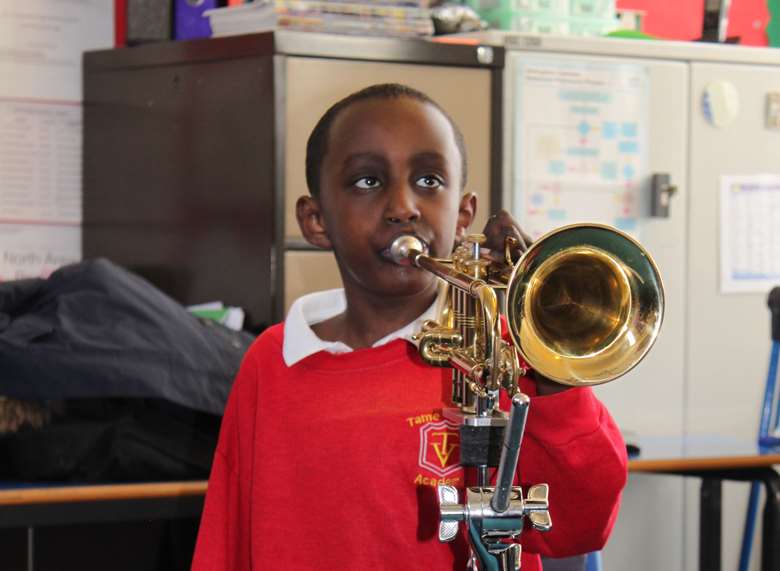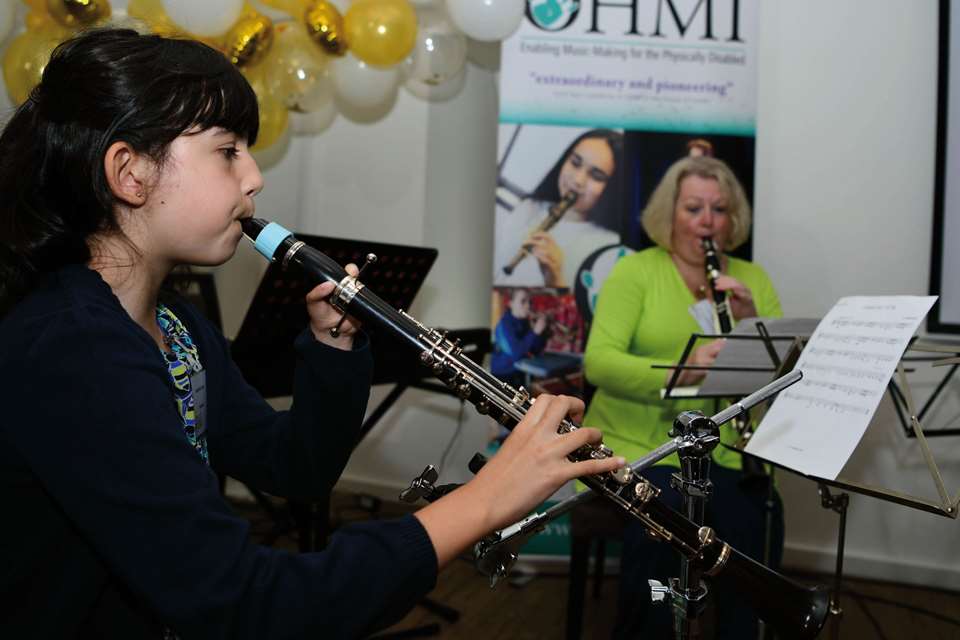Removing barriers in whole-class ensemble teaching
Emma Nenadic and Nikki Booth
Monday, May 1, 2023
Presenting the first in a series of articles from the Birmingham Music Education Research Group (at Birmingham City University), Emma Nenadic and Nikki Booth report on an inclusive whole-class ensemble teaching project.

Courtesy of the OHMI Trust
In 2011 the National Plan for Music Education (NPME) called for ‘equality of opportunity for all children’ (DfE & DCMS, 2011, p.8). Despite this, some research evidence has found that whole-class ensemble teaching (WCET) has been frequently cited as a barrier to music-making for pupils with disabilities, and that a key factor is the diffculty of accessing suitable instruments (Take It Away, 2018). This is compounded by a ‘lack of knowledge’ (Youth Music, 2020, p.10) regarding adapted instruments and equipment. The refreshed NPME, meanwhile, states that ‘a high quality music education is the right of every pupil. It should be inclusive of all, regardless of additional needs…’ (DfE & DCMS, 2022, p.42). It is crucial, therefore, that the notion of inclusivity remains within our discussions about music education.
OHMI and the IAMM project
The One-Handed Musical Instrument (OHMI) Trust is a charity which specialises in commissioning and increasing access to adapted instruments (for example, Artiphon Instrument 1, one-handed clarinet and stand, trombone stand, ear defenders, iPads and the ‘Pocket Pets’ app), to help remove barriers faced by any individual who is physically disabled.
Funded by Arts Council England, and delivered in partnership with Creative United, the Inclusive Access to Music-Making (IAMM) project was set up to offer equality of access to WCET pupils with additional physical needs in mainstream primary schools. In 2022 the project included a total of 283 participating schools within two music education hubs (MEHs): Nottingham Music Service and Northamptonshire Music and Performing Arts Trust. The IAMM project was independently evaluated by us in our capacity as research assistants from the Birmingham Music Education Research Group.
Within the two MEHs, 49 per cent of participating schools identified young people who may experience barriers to learning a musical instrument in WCET classes.
The benefits of the IAMM project
During post-project interviews some important, and inclusive, benefits became evident for pupils, visiting music teachers, and MEHs.
Firstly, young people with additional needs were able to progress in their musical learning. Through using an adapted instrument, pupils had the opportunity to learn alongside their non-disabled peers. As two music teachers commented: ‘The student would not be progressing anywhere near as fast if they were using traditional instruments…. By using adapted instruments, they’re accessing the same learning – it’s equitable… they’re getting the same chance to progress’; and [using the trumpet with stand meant that the pupil] ‘has no physical issues creating the sound… they were flying…. And the barriers that were previously there didn’t exist anymore.’
Secondly, visiting music teachers gained a much better understanding of how to support learners with additional needs. Teachers who had pupils with adapted instruments in their WCET classes were given additional training, provided by OHMI. This focused on how a young person’s additional needs could impact on their learning and what strategies could be used to support their musical learning. As two music teachers noted: ‘It’s certainly made me think very hard about how I teach. [For the Artiphon] we use coloured stickers to notate what finger to use. So, we say “red dot” or “red sticker” to those using the Artiphon and “D string” to children using the traditional instrument’; and ‘It stops you putting the default “I’m not sure this is going to work” into “how are we going to make this possible”, which is different to how I might have taught a few years ago.’
A third benefit was that young people could be identified as having additional needs at MEH level. The IAMM project brought to the fore the need to put support in place which would otherwise have gone unnoticed. Here are some comments shared with us by MEH representatives: ‘It’s highlighted children that we wouldn’t have been aware of’; ‘It didn’t figure on my radar until I became involved [with the IAMM project] and then I realised the scale of a) the problem and b) the solutions that are there’; and ‘I think it’s opened the eyes of our staff to possibilities rather than barriers.’
For the full version of our 2022 IAMM project evaluation, see the link below.
Looking ahead
As noted above, some previous research has revealed how WCET can be a barrier for pupils with physical disabilities, and that more should be done to share knowledge of adapted instruments and equipment. Through our evaluation, we found the IAMM project to be highly valuable in identifying the main challenges and how these impact young people’s music-making and learning experiences.
Of course, we acknowledge that this is only the beginning of an exciting journey. So, where to next? Well, we are delighted to say that, in 2023, the IAMM project is continuing in Nottingham and Northampton and is expanding into Birmingham’s MEH. We are also thrilled that we will be evaluating the project once again.
Links and references
-
DfE & DCMS, 2011. The Importance of Music: A National Plan for Music Education. bit.ly/3KeNTMP
-
Take It Away Consortium (2018): Make Some Noise report. takeitaway.org.uk/makesomenoise
-
Youth Music (2020) Reshape Music: a report exploring the lived experience of disabled musicians in education and beyond. bit.ly/3lPC9qO
-
DfE & DCMS, 2022. The Power of Music to Change Lives: A National Plan for Music Education. bit.ly/3JRjbbp
-
Nenadic, E. and Booth, N., 2022. Independent Evaluation: Inclusive Access to Music-Making (IAMM) Project, Birmingham City University. bit.ly/3IfvOMj


